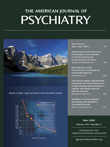Abstract
Objective: The purpose of this study was to examine the long-term stability of depressive personality disorder. Method: The subjects included 142 outpatients with axis I depressive disorders at study entry; 73 had depressive personality disorder. The patients were assessed by using semistructured diagnostic interviews at baseline and in four follow-up evaluations at 2.5-year intervals over 10.0 years. Follow-up data were available for 127 (89.4%) of the patients. Results: The 10.0-year stability of the diagnoses of depressive personality disorder was fair, and the rate of depressive personality disorder declined over time. The dimensional score was moderately stable over 10.0 years. Growth curve analyses revealed a sharp decline in the level of depressive personality disorder traits between the baseline and 2.5-year assessments, followed by a gradual linear decrease. Reductions in depressive personality disorder traits were associated with remission of the axis I depressive disorders. Finally, depressive personality disorder at baseline predicted the trajectory of depressive symptoms over time in patients with dysthymic disorder. Conclusions: Depressive personality disorder is moderately stable, particularly when assessed with a dimensional approach. However, the diagnosis rate and traits of depressive personality disorder tend to decline over time. The degree of stability for depressive personality disorder is comparable to that for the axis II disorders in the main text of DSM-IV. Finally, depressive personality disorder has prognostic implications for the course of axis I mood disorders, such as dysthymic disorder.



